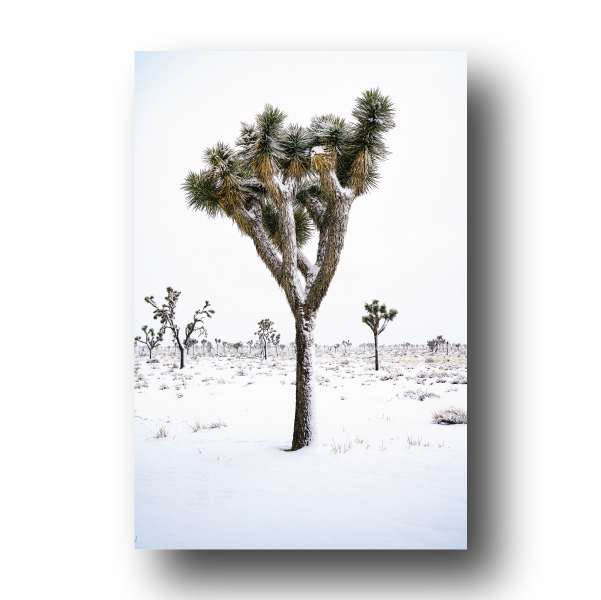Joshua Tree National Park, located in southeastern California, is a natural wonder that beckons adventurers, nature enthusiasts, and stargazers alike. With its otherworldly landscapes, unique rock formations, and a forest of iconic Joshua trees, this desert oasis offers a breathtaking experience year-round.
However, the best time to visit Joshua Tree depends on your preferences and what you hope to experience during your visit. In this seasonal guide, we will explore the different seasons and what they offer to help you plan your perfect trip to this remarkable desert gem.
A snowy Joshua Tree. Photo by Dalton Johnson
Spring: March to May
Spring is arguably the best time to visit Joshua Tree National Park. As the desert awakens from its winter slumber, the temperatures become pleasantly mild, making outdoor activities enjoyable. During this season, you'll be greeted by a stunning display of wildflowers that carpet the landscape in vibrant colors. The park's flora, including cacti and ocotillos, bloom in a riot of reds, yellows, and purples, creating a visually striking contrast against the rugged terrain.
One of the highlights of spring in Joshua Tree is the annual wildflower bloom, which varies from year to year based on rainfall. To catch the flowers at their peak, keep an eye on local reports and be ready to hit the trails. Some of the best wildflower viewing spots include the Cottonwood Spring Oasis and the Pinto Basin.
The comfortable daytime temperatures in spring also make it an excellent time for hiking and rock climbing. The crisp air allows you to explore the park's numerous trails, from easy walks to challenging hikes. Popular routes like Hidden Valley and Barker Dam are more enjoyable when the desert sun isn't scorching.
Summer: June to August
Summer in Joshua Tree brings extreme heat, and daytime temperatures can easily exceed 100 degrees Fahrenheit (38 degrees Celsius). For most visitors, summer is the least desirable time to explore the park due to the harsh weather conditions. However, if you're prepared for the heat and plan accordingly, you can still have a worthwhile experience.
If you choose to visit in summer, it's crucial to take safety precautions seriously. Hydration is paramount, so bring plenty of water, and be aware that some trails may be closed or have limited access during this season due to the extreme heat. Early morning or late evening hikes are your best bet to beat the heat, but even then, the temperatures can be oppressive.
The upside of summer visits is that the park is less crowded compared to other seasons, which means you can have a more serene experience and may even find solitude on the trails. Additionally, if you're interested in stargazing, summer nights can be surprisingly clear and ideal for observing the night sky. Just be sure to check the moon phases, as a full moon can wash out the stars.
Fall: September to November
Fall is another excellent time to visit Joshua Tree, offering a balance between pleasant weather and fewer crowds. As the scorching summer temperatures start to wane, the park becomes more inviting for outdoor activities. Daytime temperatures are generally comfortable, ranging from the 70s to 90s°F (20s to 30s°C), making it an ideal time for hiking, rock climbing, and exploring the park's unique geology.
One of the standout features of fall in Joshua Tree is the changing foliage of the Joshua trees themselves. The cooler temperatures trigger the Joshua trees to produce their iconic white and green flowers, which create a striking contrast against the deep blue desert skies. These blossoms attract a variety of pollinators, making it a fascinating time to observe the park's ecosystem.
Fall is also prime stargazing season in Joshua Tree. The clear, cool nights offer excellent visibility, and with the Milky Way stretching across the sky, it's a prime destination for astronomy enthusiasts. You can even attend ranger-led astronomy programs to enhance your night sky knowledge.
Winter: December to February
Winter brings cooler temperatures to Joshua Tree, with daytime highs averaging in the 50s and 60s°F (10s to 20s°C). While the days may be mild, the nights can get quite chilly, often dropping below freezing, so be prepared with warm clothing and suitable camping gear if you plan to stay overnight.
Winter in Joshua Tree offers a different kind of beauty. The stark contrast of the desert landscape against the snow-capped peaks of the nearby San Bernardino Mountains is a sight to behold. Hiking and rock climbing are still possible during this season, but it's essential to check weather conditions and be prepared for colder and potentially wetter weather.
One of the advantages of visiting in winter is the lack of crowds. With fewer visitors, you'll have a more peaceful experience and a better chance of securing campsites. Plus, you can explore popular attractions like Keys View and Skull Rock without the usual congestion.
Another highlight of winter visits is the opportunity to see bighorn sheep, which are more active during the cooler months. Keep your eyes peeled for these elusive creatures as you explore the park.
A solar flare poking through a Joshua Tree. Photo by Dalton Johnson
The best time to visit Joshua Tree National Park depends on your preferences and what you want to experience during your trip. Spring and fall are typically the most popular seasons due to their comfortable temperatures, wildflower blooms, and pleasant hiking conditions. However, if you can handle the extreme heat, summer offers fewer crowds and excellent stargazing opportunities. Winter, while cooler, provides a unique perspective on the desert landscape and a chance to see bighorn sheep.
Ultimately, no matter when you choose to visit Joshua Tree, you're in for a memorable adventure in one of America's most iconic national parks. Just remember to plan ahead, stay hydrated, and respect the fragile desert ecosystem to ensure a safe and enjoyable experience.







